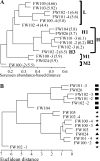Significant association between sulfate-reducing bacteria and uranium-reducing microbial communities as revealed by a combined massively parallel sequencing-indicator species approach
- PMID: 20729318
- PMCID: PMC2953039
- DOI: 10.1128/AEM.01097-10
Significant association between sulfate-reducing bacteria and uranium-reducing microbial communities as revealed by a combined massively parallel sequencing-indicator species approach
Abstract
Massively parallel sequencing has provided a more affordable and high-throughput method to study microbial communities, although it has mostly been used in an exploratory fashion. We combined pyrosequencing with a strict indicator species statistical analysis to test if bacteria specifically responded to ethanol injection that successfully promoted dissimilatory uranium(VI) reduction in the subsurface of a uranium contamination plume at the Oak Ridge Field Research Center in Tennessee. Remediation was achieved with a hydraulic flow control consisting of an inner loop, where ethanol was injected, and an outer loop for flow-field protection. This strategy reduced uranium concentrations in groundwater to levels below 0.126 μM and created geochemical gradients in electron donors from the inner-loop injection well toward the outer loop and downgradient flow path. Our analysis with 15 sediment samples from the entire test area found significant indicator species that showed a high degree of adaptation to the three different hydrochemical-created conditions. Castellaniella and Rhodanobacter characterized areas with low pH, heavy metals, and low bioactivity, while sulfate-, Fe(III)-, and U(VI)-reducing bacteria (Desulfovibrio, Anaeromyxobacter, and Desulfosporosinus) were indicators of areas where U(VI) reduction occurred. The abundance of these bacteria, as well as the Fe(III) and U(VI) reducer Geobacter, correlated with the hydraulic connectivity to the substrate injection site, suggesting that the selected populations were a direct response to electron donor addition by the groundwater flow path. A false-discovery-rate approach was implemented to discard false-positive results by chance, given the large amount of data compared.
Figures



References
-
- Akob, D. M., H. J. Mills, T. M. Gihring, L. Kerkhof, J. W. Stucki, A. S. Anastacio, K. J. Chin, K. Kusel, A. V. Palumbo, D. B. Watson, and J. E. Kostka. 2008. Functional diversity and electron donor dependence of microbial populations capable of U(VI) reduction in radionuclide-contaminated subsurface sediments. Appl. Environ. Microbiol. 74:3159-3170. - PMC - PubMed
-
- Anderson, R. T. 2006. DOE genomics: applications to in situ subsurface bioremediation. Remediation J. 17:23-38.
-
- Anderson, R. T., H. A. Vrionis, I. Ortiz-Bernad, C. T. Resch, P. E. Long, R. Dayvault, K. Karp, S. Marutzky, D. R. Metzler, A. Peacock, D. C. White, M. Lowe, and D. R. Lovley. 2003. Stimulating the in situ activity of Geobacter species to remove uranium from the groundwater of a uranium-contaminated aquifer. Appl. Environ. Microbiol. 69:5884-5891. - PMC - PubMed
-
- Benjamini, Y., and Y. Hochberg. 1995. Controlling the False discovery rate: a practical and powerful approach to multiple testing. J. R. Stat. Soc. B 57:289-300.
Publication types
MeSH terms
Substances
LinkOut - more resources
Full Text Sources

